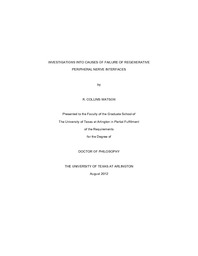
ATTENTION: The works hosted here are being migrated to a new repository that will consolidate resources, improve discoverability, and better show UTA's research impact on the global community. We will update authors as the migration progresses. Please see MavMatrix for more information.
Show simple item record
| dc.contributor.author | Watson, R. Collins | |
| dc.date.accessioned | 2016-01-28T18:03:42Z | |
| dc.date.available | 2016-01-28T18:03:42Z | |
| dc.date.submitted | January 2012 | |
| dc.identifier.other | DISS-11828 | |
| dc.identifier.uri | http://hdl.handle.net/10106/25520 | |
| dc.description.abstract | All highly selective methods of neural interfacing for mental control of a robotic prosthesis tested to date have exhibited high rates of failure over time. Regenerative peripheral nerve interfaces (RPNIs) may offer the greatest potential among the proposed technologies for providing the number of degrees of freedom necessary to control a robotic limb, but are unacceptable for clinical use due to several shortcomings of current technology: (1) all RPNIs tested to date have exhibited signal loss over time due to biological mechanisms of rejection of implanted electrodes; (2) all chronically tested interfaces have suffered from high rates of device failure of physical and mechanical origin; and (3) the technologies used to date have not yet proven capable of providing the selectivity and sensitivity of recordings that researchers hope they will obtain and that will be necessary for clinical use. Chapter 2 of this dissertation investigates the prominent causes of physical device failure inherent within current technologies. Complications regarding the transfer of internally recorded signals to the external environment via a wire represented the most common cause of device failure in a characteristic RPNI model (15% of animals over 15 days, 35% of animals over 30 days, 60% of animals over 60 days; n = 20 animals per group). While many researchers are investigating mechanisms of biological rejection of cortically implanted electrodes, including the effects of micromotion and mechanical mismatch between electrodes and brain tissue, the complementary phenomenon of tissue movement related to nerve stretch during limb movement has not yet been investigated. Chapter 3 provides evidence that nerve stretch does not accelerate signal loss, does not decrease the number of regenerating axons, and does not increase the axon-depleted-area surrounding each electrode in a characteristic RPNI model. A proposed improvement to RPNI technology is microchannel encapsulation of regenerating axons. This has been shown through mathematical predictions to amplify extracellular recordings of action potentials from both myelinated axons and unmyelinated axons, potentially increasing the sensitivity and selectivity of an RPNI and possibly reducing the impact of biological mechanisms of rejection. In vitro and in vivo experiments have supported the mathematical predictions for myelinated axons. Chapter 4 provides direct experimental support for microchannel amplification of unmyelinated axons. Chapter 5 discusses the relevance of all of these findings toward the field of neural interfacing with attention toward the future state of this technology. | |
| dc.description.sponsorship | Romero-Ortega, Mario | |
| dc.language.iso | en | |
| dc.publisher | Biomedical Engineering | |
| dc.title | Investigations Into Causes Of Failure Of Regenerative Peripheral Nerve Interfaces | |
| dc.type | Ph.D. | |
| dc.contributor.committeeChair | Romero-Ortega, Mario | |
| dc.degree.department | Biomedical Engineering | |
| dc.degree.discipline | Biomedical Engineering | |
| dc.degree.grantor | University of Texas at Arlington | |
| dc.degree.level | doctoral | |
| dc.degree.name | Ph.D. | |
Files in this item
- Name:
- Watson_uta_2502D_11828.pdf
- Size:
- 56.70Mb
- Format:
- PDF
This item appears in the following Collection(s)
Show simple item record


